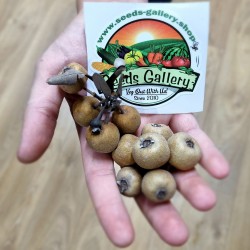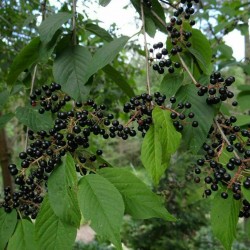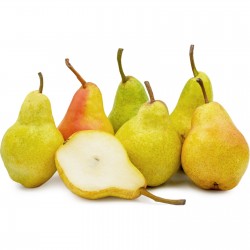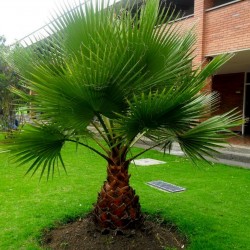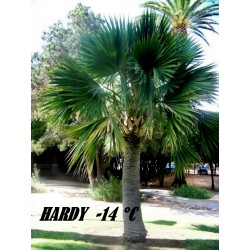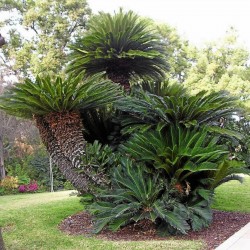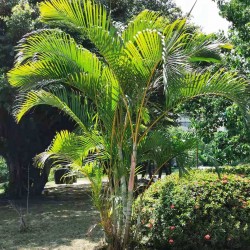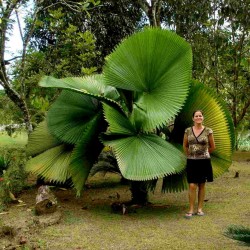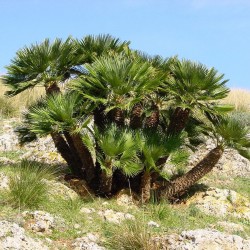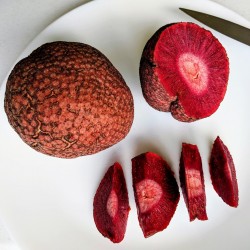
This plant is resistant to winter and frost.
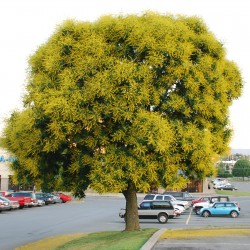
Семена Кёльрейтерия...
Цена
1,65 €
SKU: T 93
Seeds Gallery Com,
5/
5
<h2><strong>Семена Кёльрейтерия метельчатая (Koelreuteria paniculata)</strong></h2>
<h2><span style="color: #ff0000;"><strong>Цена за упаковку из 10 семян.</strong></span></h2>
<p style="color: #202122; font-size: 14px;"><b>Кёльрейтерия метельчатая</b><span> </span>(лат. <span lang="la">Koelreuteria paniculata</span>) — вид<span> </span>деревьев,<span> </span>типовой вид<span> </span>рода<span> </span>Кёльрейтерия<span> </span>семейства<span> </span>Сапиндовые<span> </span>(<i>Sapindaceae</i>). Листопадное дерево или кустарник.</p>
<p style="color: #202122; font-size: 14px;">Родина —<span> </span>Восточная Азия. В<span> </span>миоцене<span> </span>Европу<span> </span>населял ископаемый вид<span> </span><i>Koelreuteria macroptera</i>, объединённый в одну группу с кёльрейтерией метельчатой<sup id="cite_ref-3" class="reference" style="font-size: 11.2px;">[3]</sup>.</p>
<p style="color: #202122; font-size: 14px;">Популярна в<span> </span>ландшафтном дизайне<span> </span>из-за её<span> </span>эстетической<span> </span>ценности и устойчивости к неблагоприятным факторам окружающей среды.</p>
<h2 style="color: #000000; font-size: 1.5em;"><span class="mw-headline" id="Ботаническое_описание">Ботаническое описание</span></h2>
<div class="thumb tleft" style="color: #202122; font-size: 14px;">
<div class="thumbinner" style="font-size: 13.16px;"><img alt="" src="https://upload.wikimedia.org/wikipedia/commons/thumb/4/4e/Koelreuteria_paniculata_pod_3.jpg/260px-Koelreuteria_paniculata_pod_3.jpg" decoding="async" width="260" height="195" class="thumbimage" srcset="//upload.wikimedia.org/wikipedia/commons/thumb/4/4e/Koelreuteria_paniculata_pod_3.jpg/390px-Koelreuteria_paniculata_pod_3.jpg 1.5x, //upload.wikimedia.org/wikipedia/commons/thumb/4/4e/Koelreuteria_paniculata_pod_3.jpg/520px-Koelreuteria_paniculata_pod_3.jpg 2x" data-file-width="2816" data-file-height="2112">
<div class="thumbcaption" style="font-size: 12.3704px;">
<div class="magnify"></div>
Плоды</div>
</div>
</div>
<p style="color: #202122; font-size: 14px;">Дерево высотой до 15 м, обычно значительно ниже, с округлой<span> </span>кроной.</p>
<p style="color: #202122; font-size: 14px;">Ветви<span> </span>восходящие, часто сильно изогнуты.</p>
<p style="color: #202122; font-size: 14px;">Кора<span> </span>шероховатая, коричнево-серая, с продольными бороздками.</p>
<p style="color: #202122; font-size: 14px;">Почки<span> </span>размером около 2 мм.</p>
<p style="color: #202122; font-size: 14px;">Листья<span> </span>очерёдные, длиной до 35 см, непарноперистые с 7 — 17<span> </span>листочками; листочки овальные, заострённые, крупнопильчатые или городчатые, длиной 5 — 7 см.</p>
<p style="color: #202122; font-size: 14px;">Цветки<span> </span>с 4<span> </span>лепестками<span> </span>жёлтого цвета, размером около 1 см, собраны в рыхлые метёлкообразные прямостоящие<span> </span>соцветия.</p>
<p style="color: #202122; font-size: 14px;">Время цветения наступает в июне — августе.</p>
<p style="color: #202122; font-size: 14px;">Плод<span> </span>— трёхстворчатая<span> </span>коробочка, цвет — от зелёного до красно-коричневого, с множеством чёрных<span> </span>семян. Плоды созревают в сентябре — октябре. Летучие коробочки разносятся ветром.</p>
<p style="color: #202122; font-size: 14px;">Растёт быстро. Даёт корневые отпрыски<sup id="cite_ref-NC_State_4-0" class="reference" style="font-size: 11.2px;">[4]</sup>.</p>
<h2 style="color: #000000; font-size: 1.5em;"><span id=".D0.A0.D0.B0.D1.81.D0.BF.D1.80.D0.BE.D1.81.D1.82.D1.80.D0.B0.D0.BD.D0.B5.D0.BD.D0.B8.D0.B5_.D0.B8_.D1.8D.D0.BA.D0.BE.D0.BB.D0.BE.D0.B3.D0.B8.D1.8F"></span><span class="mw-headline" id="Распространение_и_экология">Распространение и экология</span></h2>
<h3 style="color: #000000; font-size: 1.2em;"><span id=".D0.92_.D0.B5.D1.81.D1.82.D0.B5.D1.81.D1.82.D0.B2.D0.B5.D0.BD.D0.BD.D0.BE.D0.B9_.D1.81.D1.80.D0.B5.D0.B4.D0.B5"></span><span class="mw-headline" id="В_естественной_среде">В естественной среде</span></h3>
<div class="thumb tright" style="color: #202122; font-size: 14px;">
<div class="thumbinner" style="font-size: 13.16px;"><img alt="" src="https://upload.wikimedia.org/wikipedia/commons/thumb/2/23/%E5%AD%90%E6%88%BF%E6%B9%96_-_panoramio.jpg/280px-%E5%AD%90%E6%88%BF%E6%B9%96_-_panoramio.jpg" decoding="async" width="280" height="184" class="thumbimage" srcset="//upload.wikimedia.org/wikipedia/commons/thumb/2/23/%E5%AD%90%E6%88%BF%E6%B9%96_-_panoramio.jpg/420px-%E5%AD%90%E6%88%BF%E6%B9%96_-_panoramio.jpg 1.5x, //upload.wikimedia.org/wikipedia/commons/thumb/2/23/%E5%AD%90%E6%88%BF%E6%B9%96_-_panoramio.jpg/560px-%E5%AD%90%E6%88%BF%E6%B9%96_-_panoramio.jpg 2x" data-file-width="2437" data-file-height="1604">
<div class="thumbcaption" style="font-size: 12.3704px;">
<div class="magnify"></div>
Каменистые низкогорья Юньтайшаня — характерные<span> </span>биотопы<span> </span>кёльрейтерии метельчатой и фисташки китайской<sup id="cite_ref-WDF_5-0" class="reference" style="font-size: 9.89632px;">[5]</sup></div>
</div>
</div>
<p style="color: #202122; font-size: 14px;">Дерево встречается в<span> </span>Восточной Азии<span> </span>(Северный и Центральный<span> </span>Китай,<span> </span>Корея,<span> </span>Япония). Северная граница ареала проходит через низкогорный пояс<span> </span>Яньшаня, то есть для растения привычен климат<span> </span>Пекина<sup id="cite_ref-6" class="reference" style="font-size: 11.2px;">[6]</sup>. На юге область распространения вклинивается в субтропический<span> </span>географический пояс<sup id="cite_ref-7" class="reference" style="font-size: 11.2px;">[7]</sup>.</p>
<p style="color: #202122; font-size: 14px;">Кёльрейтерия метельчатая является<span> </span>диагностическим видом<span> </span>в лесах, связанных с<span> </span>дубом изменчивым. Упомянута для нескольких вариантов этих<span> </span>засухоустойчивых<span> </span>дубняков<sup id="cite_ref-WDF_5-1" class="reference" style="font-size: 11.2px;">[5]</sup>. Первый отличается от второго тем, что расположен на меньшей высоте в горах, где жарче.</p>
<ul style="color: #202122; font-size: 14px;">
<li>Леса, в которых дуб изменчивый разбавлен<span> </span>фисташкой китайской,<span> </span>птероцелтисом Татаринова<span> </span>и видами<span> </span>каркаса. Южнее подключаются<span> </span>ликвидамбар формозский,<span> </span>дальбергия хубэйская<span> </span>и<span> </span>альбиция Калькора. Подлесок обычно состоит из<span> </span>витекса<span> </span>(<i>Vitex negundo</i>),<span> </span>гревии<span> </span>(<i>Grewia biloba</i>),<span> </span>линдеры<span> </span>(<i>Lindera glauca</i>), видов<span> </span>жостера<span> </span>и<span> </span>тутовника<span> </span>(<i>Morus australis</i>).</li>
<li>Леса из дуба изменчивого и других дубов с участием видов<span> </span>дзельквы,<span> </span>платикарии<span> </span>и<span> </span>граба Турчанинова. Кустарниковый слой образован<span> </span>скумпией кожевенной,<span> </span>сумахом китайским,<span> </span>форзицией пониклой,<span> </span>симплокосом метельчатым<span> </span>и видами<span> </span>спиреи. Здесь встречаются дикий<span> </span>персик Давида<span> </span>и<span> </span>рододендрон мягкий.</li>
</ul>
<p style="color: #202122; font-size: 14px;">Местообитания кёльрейтерии простираются на кипарисовые и сосново-дубовые леса. Они занимают каменистые преимущественно солнечные склоны, встречаются в верховьях сухих субтропических долин.<span> </span>Кипарис Чэна<span> </span>(<i>Cupressus chengiana</i>), похожий на<span> </span>кипарис гималайский, господствует в кипарисовых лесах. Многочисленная в смешанных лесах<span> </span>сосна китайская<span> </span>таксономически близка к<span> </span>сосне крымской. Восточный белый дуб (<i>Quercus aliena</i>) можно сравнить с<span> </span>дубом скальным, а другой полувечнозелёный вид<span> </span><i>Quercus baronii</i><span> </span>входит в секцию<span> </span>каменных дубов<sup id="cite_ref-8" class="reference" style="font-size: 11.2px;">[8]</sup>. Главным лесообразователям сопутствует несколько видов деревьев: кёльрейтерия метельчатая, граб Турчанинова,<span> </span>шелковица монгольская<span> </span>и<span> </span>айлант высочайший. Подлесок богат разнообразными кустарниками: скумпией кожевенной,<span> </span>леспедецей двуцветной,<span> </span>кампилотрописом<span> </span>и<span> </span>кизильником многоцветковым. Определённую роль в подлеске играют<span> </span>жасмин цветистый,<span> </span>аралия китайская<span> </span>и<span> </span><i>Zanthoxylum simulans</i><sup id="cite_ref-9" class="reference" style="font-size: 11.2px;">[9]</sup><sup id="cite_ref-10" class="reference" style="font-size: 11.2px;">[10]</sup><sup id="cite_ref-11" class="reference" style="font-size: 11.2px;">[11]</sup>.</p>
<h3 style="color: #000000; font-size: 1.2em;"><span id=".D0.92_.D0.BA.D1.83.D0.BB.D1.8C.D1.82.D1.83.D1.80.D0.B5"></span><span class="mw-headline" id="В_культуре">В культуре</span></h3>
<p style="color: #202122; font-size: 14px;">Культивируется как<span> </span>парковое<span> </span>и<span> </span>декоративное<span> </span>дерево во многих регионах<span> </span>Азии,<span> </span>Европы<span> </span>и<span> </span>Северной Америки. В условиях центральноевропейского<span> </span>климата<span> </span>зимостойкое, любит тепло и сухость, засухоустойчиво. На востоке Северной Америки стало инвазивным видом. Выращивается на<span> </span>Черноморском побережье России. Культурный ареал этого вида продвигается в континентальные районы юга России<sup id="cite_ref-12" class="reference" style="font-size: 11.2px;">[12]</sup>. Зоны зимостойкости (USDA): 5—9<sup id="cite_ref-NC_State_4-1" class="reference" style="font-size: 11.2px;">[4]</sup>. В регионах с губительно холодными зимами её меняют на позолоченные сорта<span> </span>карагача<span> </span>(<span>Ulmus pumila</span><span> 'Jinye'</span>).</p>
<p style="color: #202122; font-size: 14px;">Устойчива к городской среде, в частности пригодна для уличного озеленения. Она улавливает загрязнения, поступающие от автомобильных дорог, выдерживает засоление почвы<sup id="cite_ref-NC_State_4-2" class="reference" style="font-size: 11.2px;">[4]</sup>. Нетребовательна к уходу, но молодые деревья советуют кронировать для повышения декоративности и прочности. Кёльрейтерией метельчатой украшают скверы на перекрёстках, высаживают на лужайках в парках, благоустраивают ею игровые площадки и парковки. Если позволяет климат, то дерево достигает размеров достаточных для затенения тротуаров от палящего летнего солнца. Вредителями поражается незначительно. Иногда страдает от<span> </span>фитоплазмы<span> </span>и грибов-паразитов, например<span> </span>трутовика ложного. Необходимо помнить, что кёльрейтерия легко превращается в сорняк в комфортных для неё условиях<sup id="cite_ref-NC_State_4-3" class="reference" style="font-size: 11.2px;">[4]</sup><sup id="cite_ref-13" class="reference" style="font-size: 11.2px;">[13]</sup>.</p><script src="//cdn.public.n1ed.com/G3OMDFLT/widgets.js"></script>
T 93 (10 S)






